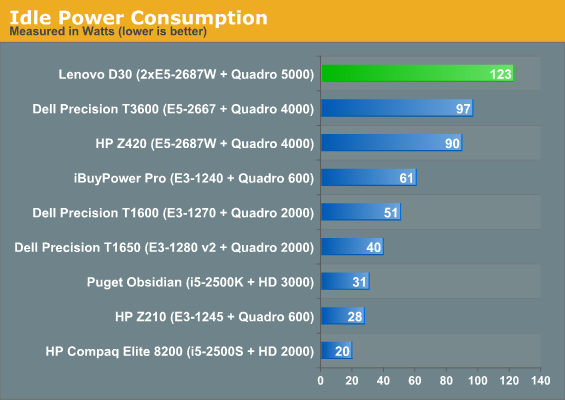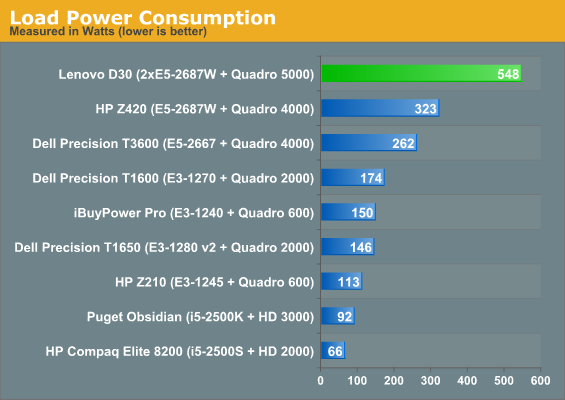Lenovo ThinkStation D30 Workstation Review: 16 Cores and 32 Threads Under Your Desk
by Dustin Sklavos on November 15, 2012 12:01 AM EST- Posted in
- Systems
- Lenovo
- Quadro
- Workstation
- Sandy Bridge E
- Enterprise
- Octalcore
Build Quality
Speaking candidly, Lenovo's internal design for the ThinkStation D30 may be at least somewhat competitive with HP's Z820's interior, but it's worlds behind Dell's Precision T7600. The design philosophy Dell rolled out with the T3600, T5600, and T7600 is probably the most thoughtful and detailed one I've seen in the workstations I've tested; Lenovo's interior in the D30 is comparably very staid and even a bit archaic in some respects.
.jpg)
For starters, the cable management is pretty poor for a system like this. For comparison's sake, below is the interior layout of the smaller Dell T3600. This isn't the most fair comparison since the D30 is a deeper case and has to support two processors, but I think the decisions involved in the design come across well enough.
.jpg)
Quite frankly, Dell's design is just cleaner. A lot of this owes to the modular power supply design they're using in their modern workstations; power supplies are designed to be easily removed and replaced out of the back of the case by the end user. Meanwhile, Lenovo's design still has a mess of cables spewing out of the back of the power supply. It's just sloppy, and worse, if the PSU goes, that's going to mean a tremendous amount of downtime.
Noise, Heat, and Power Consumption
Unfortunately HWMonitor flipped its lid trying to read the operating temperatures of the D30, but monitoring the system under load with AIDA64 revealed generally reasonable thermal performance. Noise was also for the most part a non-issue as it often is with these workstations, which is really impressive when you think about it. Lenovo was able to keep the noise level below the 30dB floor of my sound meter at idle, and then under load it peaked at a noticeable but still very tolerable 34.5dB from a foot away.
As for power consumption, it goes without saying that the D30 is going to be a bit of a monster. The combined rated wattage of the CPUs and GPU is 452W on its own, and that's ignoring the eight DIMMs and 15K-RPM mechanical hard drive.


It takes a lot of juice to sit at the top of the charts, but when you're pushing for as much raw performance as you can get (as you would with a system like this one), power consumption is really going to be a secondary concern.
.jpg)










68 Comments
View All Comments
Gunbuster - Thursday, November 15, 2012 - link
I am consistently amazed at the Lenovo product designers who can take cutting edge hardware and then make it look like it was manufactured 15 years ago. They should market it as an anti-theft feature.Haribol - Monday, November 26, 2012 - link
HAHA! I agree 100%! Recently I bought a Lenovo D30 from eBAY and it looks absolutely the same as the D20. You know what the D20 and D30 look very similar, the casing might even be the same thing. I guess some companies like to KEEP IT SIMPLE. I like that better then making it look like a creation from Mars. It is well built and I don't feel like I will break anything if I change things out. Even If I do they have an awesome warranty.Wolfpup - Thursday, November 15, 2012 - link
Oh man, 16 physical CPUs in one system...I sooooo want one of these for Folding. Throw in some extra Geforce GTX 680s too! :-Dtanishalfelven - Thursday, November 15, 2012 - link
Really... 16. I don't know about you, workstation task i'm interested in are more RAM intensive than processor intensive. At 10 grand i'd expect 128 gb at the least.KAlmquist - Friday, November 16, 2012 - link
Lenova's price list is:$150 for a 2 GB registered ECC DIMM
$300 for a 4 GB registered ECC DIMM
$650 for an 8 GB registered ECC DIMM
$1350 for a 16 GB registered ECC DIMM
So a 128GB version of this system would cost slightly over 20 grand, with more than half the cost going to the memory.
That price seems excessive to me, as well. A similar system from AVA Direct, with 128GB of memory, will cost under 10 grand. That includes a 3 year on site warranty (contracted out to Intel).
Haribol - Monday, November 26, 2012 - link
Never pay retail. Shop around on sites like eBay, Google etc for best deals!hyperchild - Thursday, November 15, 2012 - link
I just happen to look at this review so I am in no way knowledgeable in the server department but am I missing something, $10800??? I just priced all the stuff at $6,850 at new egg. So is the extra 4k for 3 years of support? Is there some special reason it has a markup like that?kkwst2 - Thursday, November 15, 2012 - link
Well, you can usually price something significantly lower by buying the components. These days it is harder with lower end stuff but the more high end the product the higher the margins are.Understand the target market for these workstations. They're for people who are doing computational modeling, professional 3D rendering, etc. They are paying for stability, support, etc.
The author points out that Dell is getting very aggressive with price with much lower margins. We use Lenovo workstations because that is who our IS has a deal with, but we don't pay retail. We would probably get this system for $7k to $8k.
bobbozzo - Thursday, November 15, 2012 - link
The worst part of it is Lenovo's markups on the CPUs are VERY high... Thousands of dollars more than purchasing 2 CPUs from Newegg. for the UPGRADE to the faster CPUs.bobbozzo - Thursday, November 15, 2012 - link
In other words, I could buy the base system from Lenovo, and buy 2 faster CPUs from Newegg, and save thousands of dollars.Perhaps the same holds true for RAM and disks.